Save A Lot To Anchor Jefferson Commons
Last week details become public for the development to be known as Jefferson Commons. You may know it by the last grocery occupant, Foodland. The development is located at Jefferson & Lafayette (Google Maps). From the developer:
Green Street and partners purchased the vacant 1601 S. Jefferson property in late 2011. Since closing on the property we have been diligently working on redevelopment plans to create a sustainable multi-tenant retail property that will provide goods and services to the community. Our anchor tenant will be Save A Lot who will occupy the 17,600 SF Suite A. In addition to Save A Lot we are in final negotiations with a nationally recognized fitness center and a nationally recognized sandwich shop. We do have additional space available at the site and we are currently talking to other prospective retailers who will be a good fit for the neighborhood. (Jefferson Commons page)
The grocery store was built originally as a Kroeger.
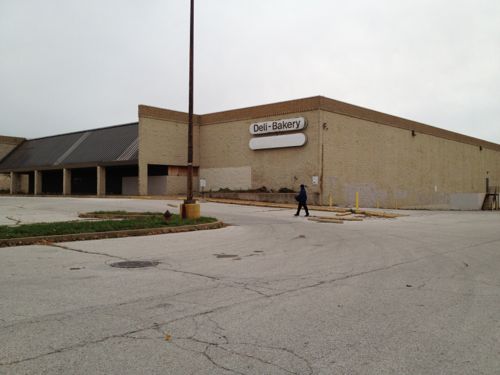
I did a 3-part series last year on this site: Part 1, Part 2, Part 3. The owner of the main site, Green Street Properties, presented their redevelopment to the community a week ago.
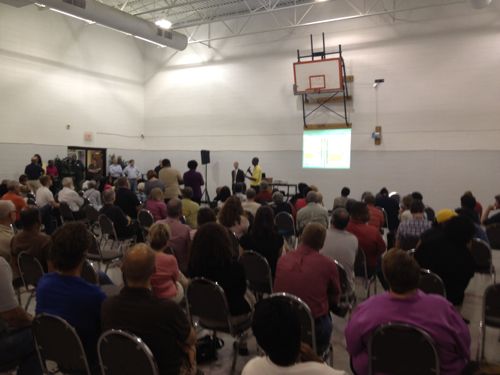
The following drawings are preliminary concepts:
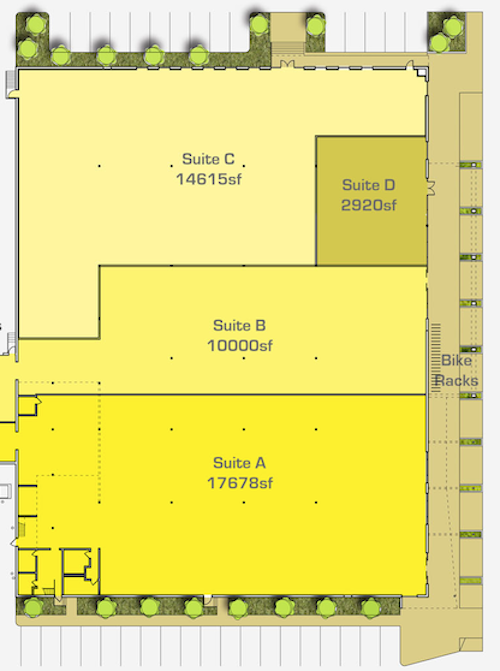
Save-A-Lot grocery would occupy “Suite A” at the south end of the building. At the meeting residents expressed both support and disappointment in Save-A-Lot. Those supporting the grocery chain said they were tired of this being vacant and they wanted a market within walking distance. Those disappointed mentioned a preference for a store with better food, such as organic, as would be the case with a Whole Foods or a Trader Joe’s. The site is in the 6th ward (Triplett) but 19th ward Ald Marlene Davis correctly pointed out that Dierberg’s, Whole Foods and Trader Joe’s aren’t coming to the city. However, I was told that Whole Foods “had an LOI in place on a urban style store in the CWE. They backed out when their pedestrian traffic counts didn’t hold up.” Pedestrian traffic counts, not vehicular traffic counts!
Other tenants in the building would include a fitness center and possibly a hardware store. Green Street doesn’t own the small strip center to the north but they are trying to acquire it. A new building would be added within the main parking lot, it includes a drive-thru.
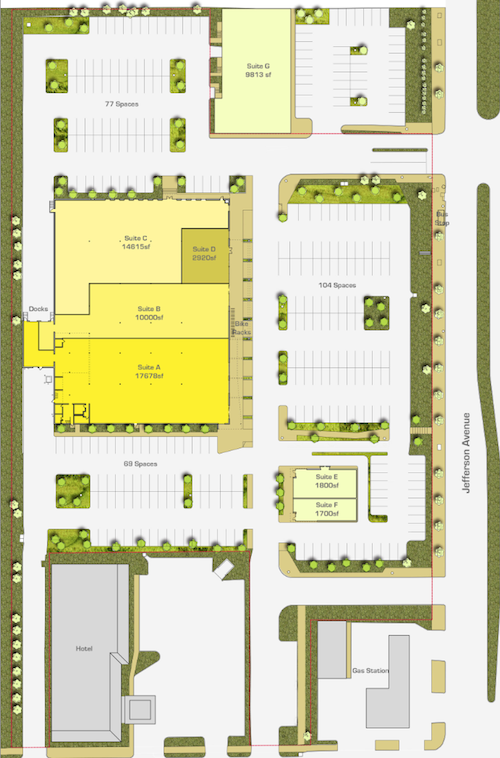
I’m happy to see pedestrian access being added but I suggested a few points via email to the architect as they finalize the site plan:
- Provide an access route to the park to the left of the upper left corner, residents currently use an opening in the fence to have direct access
- Provide an access route to the neighboring property along Hennrieta Pl so residents of that street have direct access to the site.
- Make the access route from Lafayette Ave to the main building a straight shot rather than attempting to divert pedestrians to the east.
- Provide an access route to the hotel at the south edge of the site so hotel guests can easily walk over to buy snacks or have dinner at a new restaurant.
- Distribute bike parking rather than cluster all in front of Suite B.
At the meeting two individuals said they wished the building had red brick to fit in. Both times I cringed, why must we wrap everything in the same red brick? A century ago the materials used and colors were vast.
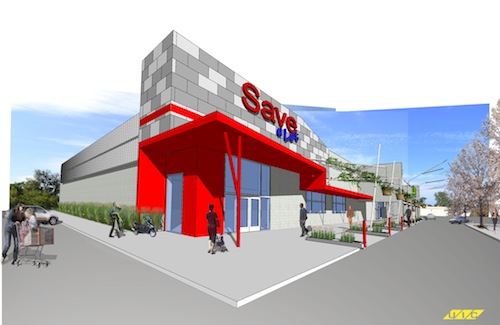
I like the modern exterior that’s proposed, a good reuse of the existing structure. Now’s your chance, share your thoughts in the comments below.
– Steve Patterson
One, this seems like a very viable project. These tenants may not be exactly what some residents may “want”, but they are likely tenants that will be successful in meeting local shopping demands. And it sure beats the vacant center, that’s been that way for years. I also like the rendering of the exterior changes.
Two, the suggestions you made to the architect all seem to make sense. The one that will probably be hardest to see implemented is with the hotel – I’m guessing the hotel installed the fence to protect their guests’ vehicles from the adjacent neighborhood, not to limit their guests access from the hotel into the shopping center.
And, three, since I correctly called Save-a-Lot as the grocery tenant in your first discussion, I’m going to predict that Gold’s Gym and Subway will be, respectively, the “nationally recognized fitness center and a nationally recognized sandwich shop.” Again, while they may not be exactly what some people “want”, they’re likely to be successful here. Bottom line, it’s good to see both reinvestment in the city AND existing structures being reused. With all the current focus on LEED and “going green”, we need to remember that if the energy inefficiencies of older structures can be addressed and mitigated, reusing existing structures, as opposed to tearing down and rebuilding new, is the greenest way to go.
The hotel could easily add a gate requiring a guest card for entry. Even if it takes 2-3 years to make the connection I’d like to see planning for such a connection happen now so it’s easier to implement later. The little strip building to the north contained a Subway for years.
The other likely option would be Jimmy John’s.
Oooh! A strip mall! Yawn.
I would have prefered a “Shop N Save”, but I am happy to see something become of the vacant property
the alderwomens corretly pointed out that whole foods, trader joes and queerbergs aren’t coming to the city. well why don’t they try to change that?
Change what?! Targeted lower taxes? Bigger TIF proposals? Eminent domain? Lower crime rates? Easier permitting? More predictability? Less interference from government officials? A standardized kickback schedule? The biggest hurdle remains demographics. The numbers that “have been proven to work” in the suburbs don’t appear to work (as well?) in grittier, more-diverse, urban areas, populated by more non-traditional “family” units. Developers just see more risk and face greater financial hurdles to do projects in St. Louis than in the surrounding suburbs, period. Trader Joe’s and, to a slightly-lesser-degree, Whole Foods are coveted as prime tenants and can, to put it bluntly, cherry pick where they choose to locate their stores. The same goes for Ikea and Nordstrom, Costco and Apple. They’re not Starbucks or Walgreens, they have no desire to be on every corner. Scarcity creates both a cachet and bigger profits. And as long as city residents continue to “give in” and drive out to Brentwood to patronize Trader Joe’s, Whole Foods and/or Apple, why should any one of them build another location in the city? Will two stores double their profits? Or, will one mostly canibalize the other? It has very little to do with emotional opinions about the city, it has a whole lot to do with their respectiive bottom lines . . . .
yes, yes, yes, yes, yes. sounds like some good ideas, why don’t they try some of that. I don’t go to brentwood, I don’t spend a single dollar in st. louis county (except at frison indoor). more city people should follow my lead. I would not go to those chain stores anyway, but it would be good for the city to get them. you love saying how “gritty” the city is,ever hear of st. louis hills? you might as well be in the county. not that i would go there, but im sure some of the stores we are talking about could survive there.
At the end of the day, those supermarket companies mentioned above, despite all of their rhetoric about organic food, helping people and being “your hometown grocery store” care about one thing: profit. If they don’t think they’ll make money on Jefferson, they’ll never build there. Are they wrong? Probably, but they have very strict measures of what they think is a viable market.
there’s an existing save-a-lot at Jefferson, just south of Cherokee, 1.5 miles south. Kind of dissapointed in the lack of variety in shopping, but will echo the sentiments of being excited that it won’t be vacant any longer.
Better than nothing I suppose, it once again highlights how the row buildings that were demolished along Jefferson to create this project are a better urban form. Right now, if those buildings were extant, there would likely be multiple businesses and multiple owners thriving given the location of surrounding historic neighborhoods.
It points to the problem of property consolidation (a la Paul Mckee on the northside) and the inability to act.)
Notice also they are breaking down the property. A throwback to the original configuration of Jefferson.
The senseless demolition that occurs is obscene, (the last few weeks a sound corner store on prosperous Cherokee).
It all ccalls into question the decision making ability of a government that continues the policies that have caused the decline of the City of St. Louis for almost 6 decades.
So yeah fiddly dee is better than fiddly dum, it evades the larger discussion about rebuilding St. Louis. That is what the government and their media handmaidens do the best, they avoid meaningful discussions that involve the citizens. With an emphasis on the word meaningful.
There’s a big difference between delaying or “stopping” demolition and convincing private-sector developers, investors and tenants that they can make a (bigger? adequate?) profit in the city (and yes, it’s all about making a profit). Were “the row buildings that were demolished along Jefferson to create this project . . . a better urban form”? Yes! But what evidence do you have that “if those buildings were extant, there would likely be multiple businesses and multiple owners thriving given the location of surrounding historic neighborhoods”? Driving either north or south on Jefferson, there’s little evidence of any sort of “thriving” business district. Mostly, it’s just a mix of what you see in much of the rest of the city – a few bars, a few owner-run restaurants, some mini-marts, some storefronts converted to offices, some newer suburbanized fast-food places, more than a few vacancies, a few churches, some industrial uses, a hotel, at least one tattoo shop and even some residential, with everything intermixed with off-street parking.
An economy grocery, a gym and a sandwich shop are neither an economic nor an urban design nirvana, but they ARE a small step in the right direction. The city can’t simply wave a magic wand and have “good” development happen. The private sector needs to want to invest, the public sector simply can’t pay for everything. But the private sector isn’t stupid, either – success begets success. If Save-a-Lot does well here, Aldi’s or Shop-and-Save will be more interested. If Subway or Jimmy John’s is a sucess, St. Louis Bread Co., Culvers and Wendy’s could become interested in investing. It doesn’t have to be (and shouldn’t be) all or nothing – incremental growth is much more sustainable. But/and the worst thing that could happen here is for these “risk takers” to not succeed, to be shunned by affluent neighbors because they’re somehow “not good enough”. If Save-a-Lot can’t make it work here, what’s the alternative, the fallback? Dollar General? Dollar Tree? Big Lots? Goodwill?! an antique mall?! another decade of vacant and boarded up?
This is not about magic wands. What it is about is a city government with the guts and foresight to proclaim how they want to redevelop all sections of the city. Transit is a factor, although coordination of transit initiatives seems to fall beyond the ability of governance.
You create your own imaginary world, only it is the world of the past. Aggressive change can occur if the past is left behind. I guess after sixty years of failure you want more?
There has been sixty years of decline listening to arguments like yours. You lose. You speculate about what can happen, sure there is no guarantee that individual businesses would have opened in a commercial row.
But the Sav a lot or whatever the hell chains that will grace our presence are okay?
I think it would have been better to cut up Ball park village into 10 or 20 parcels and let it go. Think about it, cheaper property, more buyers. Jefferson Avenue is no different. (Everyone faint, economic success is available to all)
I last remember the main store at the Jefferson site occupied, it must have been the early eighties, a few small stores hung on for while longer. The original National Food Store (I think that was it) only lasted around 5 years, (a cheaper version followed) although it has been awhile, I do remember the commercial row that marched up Jefferson towards Lafayette. The new development was basically a failure from the beginning. Viable businesses were kicked out along Jefferson Avenue to make way for this project.
The government needs to serve the people, not corporate interests. That is the underlying problem in decision making.
It has gotten to the point the failure to integrate major sites into the larger city plan is a feature of City Planning.
That failure does not relate to the considerable urban style investment on the southeast corner of Lafayette and Jefferson, nor the potential of other nearby sites. There is no rime or reason to what is happening, a historic library on the southwest corner, the Lafayette Square Historic District and so on. Apparently no aesthetic, transit, economic nor human city building issues are considered.
We have similar goals, we just have a fundamental disagreement on what role “the government” can and should play. You assert that “This is not about magic wands. What it is about is a city government
with the guts and foresight to proclaim how they want to redevelop all
sections of the city.” Proclaiming is easy, for both the public sector and the private sector, but the proof is in the pudding. “The government” can build a new streetcar line down Delmar, they can increase the allowable zoning, but it remains up to the private sector to embrace that new vision, to fill that new envelope. We can want to recreate Chicago’s Michigan Avenue along Jefferson (why not?!), but until Gucci, H+M, Crate & Barrel, Morton’s and Tiffany & Co. decide to move in, it ain’t gonna happen. We could build a new streetcar line along Jefferson (why not?), but until people and businesses want to be (t)here, the current development patterns will continue.
You proclaim that I “create [my] own imaginary world, only it is the world of the past.
Aggressive change can occur if the past is left behind. I guess after
sixty years of failure you want more?” No, I live in the real world, one where change only happens when people are willing to invest in change, to spend money, be it tax dollars or private equity. Save a Lot wants to be here. Why not embrace a small success in a challenging area? You “last remember the main store at the Jefferson site occupied, it must
have been the early eighties, a few small stores hung on for while
longer.” For thirty(!) years, nothing much happened here. Is it “the government’s” fault? I don’t think so. And while I think it’s a direct result of significant shifts in housing patterns (aka white flight), which was a direct result of governmental actions, I don’t think that those actions by the government to address discrimination were wrong. Given the amount of racism that is still palpable in our region, I’m not sure I’d even want to be here in the 50’s, 60’s and 70’s.
We agree that the private auto, the SOV, has had a HUGE impact on the urban form, the built environment. You seem to want to significantly change this paradigm, to invest huge sums in a robust transit infrastructure, assuming that “build it and they will come”, that people can be convinced to choose transit for trips other than their daily commutes (transit’s primary market). Most of us aren’t Steve. Most of us aren’t searching for something different than our cars, we’re just searching for a parking spot. Most of us don’t want to plan our lives around schedules and to spend two, three or more times as long to get from A to B, we simply don’t have that luxury of excess time in our busy lives. Yes, today’s buses and streetcars are certainly acceptable transit capsules – they’re clean and air-conditioned and usually running on schedule – but they’re rarely as convenient as just getting in and going. You may view this as selling out to corporate interests, I just view this as choosing what works best for me, given the options available.
Finally, you state that “There has been sixty years of decline listening to arguments like” mine. Um, no. Yes, there have been sixty years of decline IN THE CITY. In both the region and much of the rest of the United States, especially in the sun belt, the last sixty years has seen significant growth and success, mostly using the autocentric model that defines suburbia. So just because it doesn’t work here, it’s a “failure”? Or, have we simply “missed the boat” in the city, clinging to the past? Wondering why all these Luddites “don’t get it”? Wondering where all these cars came from and why only poor people choose transit? There will always be a subset of the population that will embrace your vision, your utopia, just like there will always be a subset that embraces mine. I’m willing to coexist with many choices, including ones that I would never choose (Wildwood, Cottleville), I just don’t want “the government” telling me that I can’t have choices!
This is still a good location for a grocery store, but the reality is that full-line grocery stores now have to compete with Wal-Mart and Target… so Save-a-Lot fills a good niche as a limited service, limited lines option.
This was originally built as Kroger in 1983-84 or so, they pulled out of the St Louis market in 1986, then sold this location, among many others, to National Supermarkets. National was bought by Schnucks in 1995. The S. Jefferson store was one of those mandated by the FTC to be divested, which was then purchased by James Gibson’s ‘new’ National. That chain went out of business in 1999, and shortly after that Foodland took over, lasting until 2004.
So, it had enough viability as a grocery store that it lasted 20 years, and the automobile traffic counts at that location are quite high, although a lot of that is suburban commuters coming from South County and headed toward I-64 westbound. Nevertheless, I like that they’re repurposing an existing building and trying to get a mix of retail. It’s not perfect, but given the current state of retail and commercial property in general, I think this is a good option. GreenStreet hasn’t been afraid to take on tough locations and tough properties, although I think this is their first retail project. I hope it works.
The bottom line is $$$$. and Save a lot will bring in more than a Whole Foods and from a wider audience. Plain and simple.
Agree, the bottom line is $$$$. Disagree that Save a Lot will bring in more than a Whole Foods or from a wider audience. It’s all about location, location, location. A Whole Foods draws from a larger geographic area than a Save a Lot does, and probably generates more profit per square foot. The challenge is convincing Whole Foods shoppers to patronize a store at the this particular location. Yes, there are some Whole Foods customers nearby, but there are a whole lot more Save a Lot customers nearby. A Save a Lot is more likely to be successful, given the demographics, here.
too many black people around, that’s the real reason why a quality store won’t come here.
Since no one else is willing to call you on your racist statement, I will. Yes, this is primarily a lower-income area, and yes, many of the residents are African-American, but the reason a “quality store won’t come here” is green, not black. Retailers can care less what race(s) their customers are, as long as they a) have money to spend, b) spend it in their store(s), c) don’t steal, and d) don’t scare other customers away, period. While a small portion of the black community includes thieves and scary characters, the same can be said of the white, brown and yellow communities, as well, to use your parlance.
It’s lower income than the other side of Jefferson but its middle class.
Your response may be a bit excessive and is certainly naive in my opinion, JZ71. I don’t interpret Jghg’s comments as necessarily racist. They’re certainly not PC, but not necessarily racist. I think he’s on to something. Why, for example, doesn’t Dierbergs (or Walmart, Whole Foods, Trader Joes and a whole bunch of others) own stores located in the City? The reason is obvious: the money that Dierbergs and others would earn in a City store wouldn’t be as green as what they’d earn at certain county stores. But why? I think the answer lies somewhat in one short chapter in the history of retailing in STL City. Why did Schnucks close its north-of-downtown store several years ago? Why did Kroger (then National, then Food World) close its Jefferson Ave store? (People in these neighborhoods have to eat too!) Why does the Lindell Schnucks hire an armed guard (or 2) even during daylight hours. (Why doShop N Save/Aldi hire armed guards at some of the more integrated store locations–and not at some of their county locations?) What was ONE REASON Famous Barr struggled downtown during the latter years, threatening to close even before Macy’s entered the picture? Why are steel bars installed in nearly every storefront in NSL? And also on several storefronts in more integrated areas of SSL? Why is there a PERCEPTION that it’s less safe to shop North of 64/40 than in St. Louis Hills? There is a common thread here, and RIGHT OR WRONG, it’s pervasive. It’s a “black” thing. Is everyone who holds this opinion a racist? I don’t know what the answer is, but I do know that everyone who has a healthy respect for the safety of his family is NOT a racist. I wait until I’m in the county each evening before I spend my money at a store. Why? It’s perception, I’m sure. But nevertheless, it’s real. And retailers understand this! And secretely, while they’re discussing future store locations in the boardroom, this issue directs their decisions. You can bet on it! I don’t know Jghg–and I don’t recall ever reading one of his previous posts (if any), but I admire him/her for having the balls to state what he did. And your response was just a bit too judgmental in my opinion. (I think Shakespeare may have spoken to this issue once or twice!)
Most poor people in St. Louis are black, and increased crime usually mirrors increased levels of poverty. Go to someplace like Denver, where the Hispanic population far outnumbers the black population, and you find more crime committed by Hispanics than by blacks. It’s a numbers issue, not a race issue. While many St. Louisans equate “poor”, “black” and “crime”, the real equation is poor + crime, not black + crime. Educate any race and provide adequate job opportunities and crime drops. Accept a crappy public school system, drive away jobs and encourage people with the means to to move to the suburbs (forced busing) and you create cesspool of both poverty and crime. And as long as a significant number of St. Louisans continue to profile most blacks as potential criminals, based solely on their skin color, we’re going to lag beyond the rest of the country.
You know, I’m wondering if you and Jghg might not be on parallel paths! While he “said” it, you “described” it. But in essence, you are both saying the same thing….and I wouldn’t say necessarily that either of you appear to be racist.
In some ways we are, in other ways we are not. I’ll concede that we all have our prejudices, based both on direct experience and on what we’ve been told or taught. Racism, itself, is an insidious problem, since none of us gets to choose our race (or age, sex, height or sexual orientation). Everything else is pretty much up for grabs, things we more or less “control” – completing one’s education (or not), not being a criminal (or not), learning the King’s English (or not), not being obese (or not), learning basic work skills (like showing up on time, every day, and working hard while “on the clock”.) (or not) and/or not getting pregnant in high school (or not).
The following article is one of many out there documenting the the rise of the black middle class. The challenge facing St. Louis is what you allude to – much of the core city is poor, with significant crime issues. The fact that many of the residents of these areas are also black is actually (or should be) secondary, not the primary identifier. But because of the high amount of correlation, it’s hard to avoid the connection. The downside is the old cliche about “assume” – the black you see on the street could just as easily be a politician or CEO as they could be criminal.
http://www.governing.com/topics/economic-dev/gov-new-black-south.html
Omnia mutantur, nos et mutamur in illis….!
“Racism, itself, is an insidious problem, since none of us gets to choose our race (or age, sex, height or sexual orientation).” Sexual Orientation?? Please…
So, I guess you believe that sexual orientation is learned, just like you believe that “too many black people around, that’s the real reason why a quality store won’t come here.”
Those are two completely separate issues, one of which has nothing to do with the topic of this article. That was my point. Stay on issue. If you want to discuss something as pointed as sexual preference, let’s do it elsewhere. I’d be happy share some scientific data with you. As to my black population comment, it too is a fact. It is not a racist statement.
Please explain how “too many black people around” is NOT a racist statement! “Racism: the belief that races have distinctive cultural characteristics determined by hereditary factors and that this endows some races with an intrinsic superiority over others.” Are you saying that if the large black population here were replaced by a predominantly Asian (or white or Mexican or Bosnian) population, WITH THE SAME LIMITED ECONOMIC RESOURCES as the current black community, that more “quality stores” would come here?! The retail challenges here include limited disposable income (due to poverty) and, probably, increased “shrinkage” (due to shoplifting). This is an income / poverty / demographics issue, NOT a “black” issue! Doing business in ANY poor neighborhood is more of a challenge than doing business in wealthier neighborhoods. And equating poverty to any particular race IS racist!
Please re-read the comments by msrdls. He/She says it exactly as it is. I couldn’t say it better, so I won’t.
We’ll obviously never agree on this one, and I don’t read latin. But if you’re referring to msrdls’ previous comment that “it’s pervasive. It’s a “black” thing” and that a healthy fear of shopping in the city is a good thing, please, it wasn’t even worth the effort to respond to that screed.